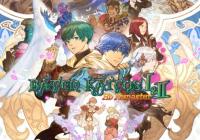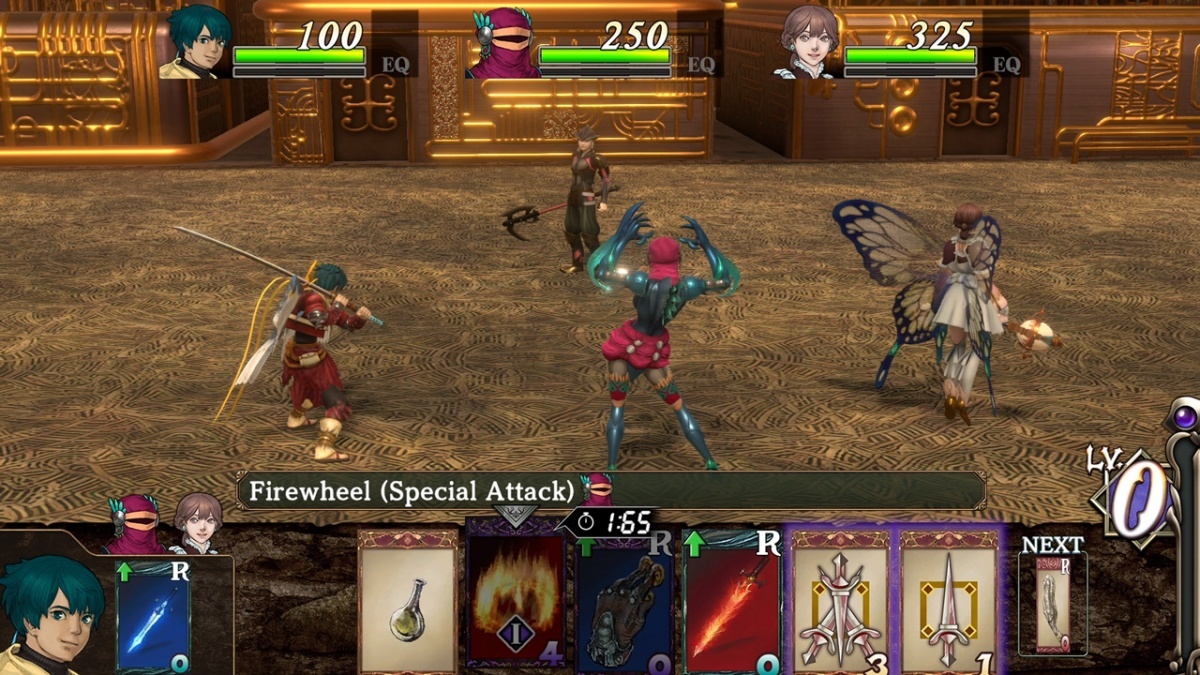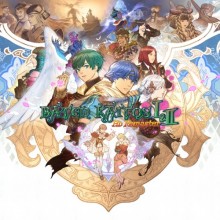Baten Kaitos I & II HD Remaster (Nintendo Switch) Review
By Coller Entragian  15.04.2025
15.04.2025

When Monolith Soft and Bandai Namco released Baten Kaitos for the Nintendo GameCube, it marked the inception of a duo of RPGs that would captivate players with its unique blend of traditional turn-based RPG elements and an innovative card-based battle system. This game not only introduced players to a novel gameplay experience, but also set the stage for a rich and imaginative world coupled with a deep and engaging storyline. Regretfully, both Baten Kaitos titles failed to find an audience on GameCube, and while used copies ultimately became expensive collector's items, the developer found success with the Xenoblade series. How have the Baten Kaitos games aged? What can be expected from these remastered ports?
Some of the distinguishing features of Baten Kaitos I & II HD Remaster are the card-based battle systems. Instead of the typical turn-based combat where characters select actions from a menu, cards are collected that serve as representations of various attacks, spells, and abilities. These cards are then utilised during battles to execute actions. This system adds a layer of strategy to the game, as one must carefully choose which cards to use in different situations, taking into account their effectiveness against specific enemies and their tactical value.
The card-based battle system is not only a gameplay mechanic but also a thematic element that ties into the narrative. It creates a sense of interconnectivity between the universe and the user input, making it an integral part of the overall experience. This world is characterised by its vivid and imaginative design, filled with diverse environments, unique creatures, and intriguing characters. The series unfolds on remarkable floating continents, breathtaking settings suspended high above the Earth's surface. These continents ascended into the sky a thousand years ago following a devastating conflict among deities that left the terrestrial world contaminated and unsuitable for habitation.
Eternal Wings and the Lost Ocean follows Kalas, a young soul burdened with an artificial Wing of the Heart, an emblem of a life forever altered. He is not alone on this peculiar path, for destiny has a way of bringing together the unlikeliest of allies. In the shadows of a powerful empire's tyranny, Kalas crosses paths with Xelha, a Mystical Waif fleeing from the grasp of malevolent benefactors. United by their shared adversary, they embark on a journey that will take them across the sprawling archipelago of floating islands, each holding secrets and dangers of its own.

The heroes search for the five End Magnus, ancient and potent artefacts scattered across the islands. But these aren't just any relics; they contain fragments of the malevolent god, Malpercio, imprisoned within. As they gather these pieces of an ancient evil, they'll unlock mysteries and face perils beyond imagination. Every step forward reveals more questions than answers, and every victory comes at a cost. Kalas and Xelha's odyssey is where the line between heroism and villainy blurs, and the fate of worlds rests upon their shoulders.
The other title in this compilation is Baten Kaitos Origins, which is about Sagi, a youth who once swore allegiance to the mighty Empire. He finds himself cast into the abyss of betrayal and framed for the most heinous of crimes: the assassination of the emperor. In his desperate quest to clear his name and seek justice, Sagi delves into the murky depths of political intrigue. He aligns himself with one of the candidates vying for the vacant throne, hoping to unearth the truth hidden beneath layers of deceit and darkness, but the shadows hold more secrets than he could ever imagine.
At the heart of this web of intrigue lies the soul-eating Machina, a malevolent force that hungers for the very essence of humanity. As Sagi treads the perilous path to redemption, he must confront this otherworldly menace, for its power threatens to consume not just his world, but the very souls of all who dwell within it.
Both stories in Baten Kaitos I & II HD Remaster are engrossing and are consistent with the level of quality expected from the same team that was responsible for Xenosaga and Xenoblade. The scenarios have really surprising twists that toy with the conventions that most JRPG fans would expect, and the care put into the writing makes it easy to get emotionally invested with the cast. Between the two games, Origins proves to be the better written due to Sagi being a more complex character who endures some admittedly horrific events, and it is paced better.

The world that Baten Kaitos I & II HD Remaster is set in can be best described as "Pacific Islander-punk set in the sky". There is a strong East-Asian flavour in all of the designs. It is present in the costumes, the depicted culture, as well as the architecture. Fans of Final Fantasy X and Chrono Cross will feel right at home in these locations.
The graphics hold up very well considering that both games are around 20 years old. The prerendered backgrounds used some sophisticated AI trickery to smooth out the low-resolution image quality and the results are convincing. It helps that the backgrounds are fully animated, thus lending a living, breathing atmosphere to the environments. The fixed camera placement makes each shot look picturesque and inviting yet striking enough to guide the player's emotions.
Character models also aged nicely. Everyone has a distinct colour palette and defined silhouette that makes each figure stand out from one another. The only aspect of the visuals that does not hold up are the animations. Baten Kaitos I & II are JRPGs from the early to mid-2000s and they have some very awkward animations that are used to depict minor actions. It wasn't a big deal when these titles were new because they were displayed on low resolution displays, but in HD their limitations have become distractingly apparent.
Sadly, the biggest failing in Baten Kaitos I & II HD Remaster is not anything in the original games. Somebody thought it was a good idea to include game-breaking boosters. It is understandable to implement some quality-of-life additions to older games, especially in today's fast-paced society, but the additions in this remaster utterly defeat the point of playing. The aforementioned card-based battle system in these games were a clever stroke of genius that made every battle varied and cut out a lot of the tired aspects of JRPG character progression. The boosters should have enhanced the existing system by increasing the effects of each card, yet instead any damage the party does will instantly kill every target - including all bosses.

Allowing players to disable all encounters and effortlessly win battles presents a double-edged sword. While these features can be appealing to some players, they risk stripping away the fundamental incentives for engaging with the game's intricate systems.
When the ability to entirely bypass encounters and breeze through battles exists, the core gameplay experience becomes shallow and devoid of challenge. In JRPGs, the sense of progression and accomplishment often comes from overcoming obstacles, defeating enemies, and honing one's skills. When these challenges are removed, it is easy to miss out on the satisfaction that comes with mastering the mechanics and strategy. It is understandable to strike a balance that caters to a diverse player base. For newcomers to the JRPG genre, the existing difficulty level may be intimidating, potentially discouraging them from fully enjoying the game.
Baten Kaitos I & II HD Remaster could have offered a choice between two distinct settings: "classic" and "rearranged." The "classic" mode would faithfully preserve the original difficulty level, catering to longtime fans who seek the authentic experience. A theoretical "rearranged" mode would provide an easier and more approachable experience for beginners, rebalanced to offer a gentler learning curve, introducing core gameplay elements gradually. This way, novice JRPG gamers could still enjoy the story and world of Baten Kaitos I & II HD Remaster without feeling overwhelmed, while also being gently nudged towards understanding the intricate systems and mechanics. In its current state, Baten Kaitos I & II HD Remaster can feel like fighting with one hand tied behind your back. When the prospect to easily overcome any adversity is only a button press away, the game is no longer challenging the player - instead the player is challenging themselves.

Cubed3 Rating
Good
Baten Kaitos I & II HD Remaster is frustrating because it is so close to being great and is only undermined by its utterly perplexing choices put into the boosters. The meta of resisting the boosters is too distracting for the experience, and succumbing turns these games into walking sims with some visual novel elements. The new UI elements have an air of "mobile game" about them, but thankfully the in-game visuals still look hot, and the QOL feature to speed up combat is a worthwhile addition. Baten Kaitos I & II are not the best from Monolith Soft, but they are both still way better than Xenosaga: Episode II and are roughly on the same level as Xenoblade Chronicles 2. Even without the boosters, there are better retro JPRGs out there, but few of them will look as nice as these.

![]() 6/10
6/10
![]() 0
(0 Votes)
0
(0 Votes)
 None
None  None
None  None
None  None
None Comments
Comments are currently disabled

 Sign In
Sign In Game Details
Game Details Subscribe to this topic
Subscribe to this topic Features
Features





 Top
Top

